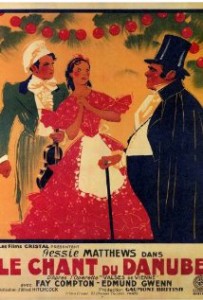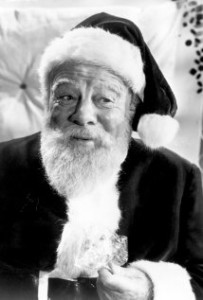Waltzes from Vienna *** (1933, Edmund Gwenn, Jessie Matthews, Fay Compton, Esmond Knight, Frank Vosper) – Classic Movie Review 2293
And now for something completely different from director Alfred Hitchcock, whose surprise 1933 movie tells the story of Johann Strauss the Elder and Johann Strauss the Younger. Isn’t this giving sons the same name as their dads thing confusing?
Tom Arnold’s production provides an ideal romantic musical vehicle for the charming and then greatly in demand ingénue Jessie Matthews. Edmund Gwenn and Esmond Knight are equally charming in their own different ways as the rival father and son Strausses.
In the story, young Schani, Johan Strauss Jr, (Knight) is forced by his father to forget music and toil in a bakery, where he falls in love with Rasi (Matthews) who becomes his fiancée.
But Rasi gets jealous when the rich and beautiful Countess Helga von Stahl (Fay Compton) asks Schani to write a waltz for her. The Countess and Prince Gustav (Frank Vosper) have a plan to swap Schani for old Johann Strauss (Gwenn). Schani writes and plays the waltz, but of course he remains faithful to Rasi.
It’s an enjoyable, stagey experience with lively work from a surprise director in theatre-lover Hitchcock, who much later pretended he didn’t like this kind of thing. He said this film was ‘the lowest ebb of my career’. Nevertheless, at the time, he was much involved with the film-making process. ‘Every cut in the film was worked out on script before shooting begins,’ he said. ‘But more than that, the musical cuts were worked out, too.’
In some sequences the images were cut to conform to the rhythm of the music. ‘Film music and cutting have a great deal in common,’ he added. ‘The purpose of both is to create tempo and mood of the scene. And, just as the ideal cutting is the kind you don’t notice as cutting, so with music.’
Providing a smooth screenplay, Hitchcock’s wife Alma Reville helps Guy Bolton to adapt the great London Alhambra stage show success by Heinz Reichert and Ernst Marischka, with of course music from Johann Strauss Elder and Younger. Though it’s a shame that it’s in black and white, it’s a good-looking film, with handsome sets by Alfred Junge and Peter Proud and striking cinematography by Glen MacWilliams.
Also in the cast are Robert Hale, Hindle Edgar, Marcus Barron, Charles Heslop, Sybil Grove, Bill Shine Jr, Bertram Dench, B M Lewis, Cyril Smith and Betty Huntley Wright.
It is also known as Strauss’ Great Waltz.
Matthews and Gwenn had just teamed together in The Good Companions, and Gwenn was to reappear memorably in Hitchcock’s Foreign Correspondent (1940) and, especially, The Trouble with Harry (1955). Gwenn also appeared in Hitchcock’s 1931 The Skin Game and his last appearance at the age of 80 was in a 1957 episode of the TV show Alfred Hitchcock Presents.
© Derek Winnert 2015 Classic Movie Review 2293
Check out more reviews on http://derekwinnert.com
The Trouble with Harry (1955).






